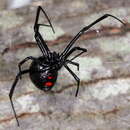en
names in breadcrumbs


The shiny black body and legs of the Northern Black Widow (Latrodectus variolus) are striking. The globose abdomen is typically decorated on its underside with two usually distinct red marks and has a row of red spots extending down the upper side of the abdomen (the slightly smaller Southern Black Widow, L. mactans, which has an overlapping distribution but is more common in the southern part of its range, often lacks these dorsal spots and the red markings on the underside of the abdomen are usually joined together in an hourglass shape). The much smaller male has abdominal markings that are more red-orange and a continuous or broken red-orange stripe bordered by white down the dorsal midline of the abdomen, as well as several pairs of diagonal white stripes along the sides of the abdomen. Young females often show a pattern similar to that of males. Female length is around 9 to 11 mm, but males are only 5.5 to 6 mm long.
The Northern Black Widow makes an irregular web of very strong and coarse silk, usually near the ground around tree stumps, in woodpiles, under stones and loose bark, around water faucets, in holes in the ground, and in garages, barns, storage buildings, and outhouses. When possible, it will retreat in the presence of a human interloper. Often the egg sac can be seen within the irregular web, guarded by the female. The somewhat pear-shaped egg sac is pale gray to yellow or tan, around 13 to 14 mm in length and 10 to 12 mm in diameter, most often spreading at the top.
Although the Northern Black Widow is widely distributed in the eastern United States (east of Kansas, Oklahoma, and Texas), it is more common in the northern part of its range. Most people who are bitten by these spiders have accidentally trapped the spider against their body or touched the web. Anyone bitten by a black widow should seek professional medical attention immediately. Vetter and Isbister (2008) provide a recent review of medical aspects of spider bites.
a
Latrodectus variolus, the northern black widow spider or northern widow, is a venomous species of spider in the genus Latrodectus of the family Theridiidae. The population is closely related to the southern black widow, Latrodectus mactans, and the western black widow, Latrodectus hesperus, of the genus.
In North America, the species is commonly found in Middle Atlantic states (New Jersey, Delaware, Maryland). During the April–May mating season, it can travel north along the coast as far as Massachusetts. It is also found in Connecticut in the late summer, and rarely, in southern Ontario and southern Quebec,[2] Michigan,[3] and at least as far northwest as parts of Wisconsin.[4]
A bite may cause latrodectism, and requires medical attention in the case of increasingly severe discomfort or spreading local redness accompanied by severe pain.[5] Other symptoms, which can last up to a week, may include body aches, severe pain, fever, inflammation, nausea, and vomiting.[6] Bites to humans are not typically deadly except in infants and the elderly. The LD-50 has been measured in mice as 1.20–2.70 mg (0.019–0.042 gr); each spider contains about 0.254 mg (0.0039 gr) of venom.[7]
Unlike for the related Latrodectus mactans, as of 2015 no antivenom was available.
Latrodectus variolus, the northern black widow spider or northern widow, is a venomous species of spider in the genus Latrodectus of the family Theridiidae. The population is closely related to the southern black widow, Latrodectus mactans, and the western black widow, Latrodectus hesperus, of the genus.
In North America, the species is commonly found in Middle Atlantic states (New Jersey, Delaware, Maryland). During the April–May mating season, it can travel north along the coast as far as Massachusetts. It is also found in Connecticut in the late summer, and rarely, in southern Ontario and southern Quebec, Michigan, and at least as far northwest as parts of Wisconsin.
A bite may cause latrodectism, and requires medical attention in the case of increasingly severe discomfort or spreading local redness accompanied by severe pain. Other symptoms, which can last up to a week, may include body aches, severe pain, fever, inflammation, nausea, and vomiting. Bites to humans are not typically deadly except in infants and the elderly. The LD-50 has been measured in mice as 1.20–2.70 mg (0.019–0.042 gr); each spider contains about 0.254 mg (0.0039 gr) of venom.
Unlike for the related Latrodectus mactans, as of 2015 no antivenom was available.